
Here you can study for the exam. Look up keywords and learn definitions about all kind of subjects.
More subjects
Cooper's hawk (Accipiter cooperii) is a medium-sized hawk native to the North American continent and found from southern Canada to Mexico. This species is a member of the genus Accipiter, sometimes referred to as true hawks, which are famously agile, relatively small hawks common to wooded habitats around the world and also the most diverse of all diurnal raptor genera. As in many birds of prey, the male is smaller than the female. The birds found east of the Mississippi River tend to be larger on average than the birds found to the west. It is easily confused with the smaller but similar Sharp-shinned hawk. (Source: Wikipedia.org, CC BY-SA)
Phalacrocoracidae is a family of approximately 40 species of aquatic birds commonly known as cormorants and shags. Several different classifications of the family have been proposed, but in 2021 the IOC adopted a consensus taxonomy of seven genera. The great cormorant (Phalacrocorax carbo) and the common shag (Gulosus aristotelis) are the only two species of the family commonly encountered in Britain and Ireland and 'cormorant' and 'shag' appellations have been later assigned to different species in the family somewhat haphazardly. (Source: Wikipedia.org, CC BY-SA)
Cranes are a family, the Gruidae, of large, long-legged, and long-necked birds in the group Gruiformes. The 15 species of cranes are placed in three genera, Antigone, Balearica, and Grus. Unlike the similar-looking but unrelated herons, cranes fly with necks outstretched, not pulled back. Cranes live on most continents, with the exception of Antarctica and South America. They are opportunistic feeders that change their diets according to the season and their own nutrient requirements.[citation needed] They eat a range of items from small rodents, eggs of birds, fish, amphibians, and insects to grain and berries. (Source: Wikipedia.org, CC BY-SA)
The term crested penguin is the common name given collectively to species of penguins of the genus Eudyptes. The exact number of species in the genus varies between four and seven depending on the authority, and a Chatham Islands species became extinct in recent centuries. All are black and white penguins with yellow crests, red bills and eyes, and are found on Subantarctic islands in the world's southern oceans. All lay two eggs, but raise only one young per breeding season; the first egg laid is substantially smaller than the second. (Source: Wikipedia.org, CC BY-SA)
The crested caracara (Caracara plancus) is a bird of prey in the family Falconidae. It is found from the southern United States through Central and South America to Tierra del Fuego. It was formerly placed in the genus Polyborus. The crested caracara has a total length of 50–65 cm (20–26 in) and a wingspan of 120–132 cm (47–52 in). Its weight is 0.9–1.6 kg (2.0–3.5 lb), averaging 1,348 g (2.972 lb) in seven birds from Tierra del Fuego. (Source: Wikipedia.org, CC BY-SA)
A crow is a bird of the genus Corvus, or more broadly a synonym for all of Corvus. Crows are generally black in colour. The word 'crow; is used as part of the common name of many species. The related term 'raven' is not pinned scientifically to any certain trait, but is rather a general grouping for larger Corvus spp. (Source: Wikipedia.org, CC BY-SA)
Cuckoos are birds in the Cuculidae /kjuːˈkjuːlɪdiː/ family, the sole taxon in the order Cuculiformes /kjuːˈkjuːlɪfɔːrmiːz/. The cuckoo family includes the common or European cuckoo, roadrunners, koels, malkohas, couas, coucals and anis. The coucals and anis are sometimes separated as distinct families, the Centropodidae and Crotophagidae respectively. The cuckoo order Cuculiformes is one of three that make up the Otidimorphae, the other two being the turacos and the bustards. The family Cuculidae contains 150 species which are divided into 33 genera. (Source: Wikipedia.org, CC BY-SA)
The curlews (/ˈkɜːrljuː/) are a group of nine species of birds in the genus Numenius, characterised by their long, slender, downcurved bills and mottled brown plumage. The English name is imitative of the Eurasian curlew's call, but may have been influenced by the Old French corliu, 'messenger', from courir , 'to run'. It was first recorded in 1377 in Langland's Piers Plowman 'Fissch to lyue in þe flode..Þe corlue by kynde of þe eyre'. In Europe 'curlew' usually refers to one species, the Eurasian curlew (Numenius arquata). (Source: Wikipedia.org, CC BY-SA)
The dodo (Raphus cucullatus) is an extinct flightless bird that was endemic to the island of Mauritius, which is east of Madagascar in the Indian Ocean. The dodo's closest genetic relative was the also-extinct Rodrigues solitaire. The two formed the subfamily Raphinae, a clade of extinct flightless birds that were a part of the family which includes pigeons and doves. The closest living relative of the dodo is the Nicobar pigeon. A white dodo was once thought to have existed on the nearby island of Réunion, but it is now believed that this assumption was merely confusion based on the also-extinct Réunion ibis and paintings of white dodos. (Source: Wikipedia.org, CC BY-SA)
Duck is the common name for numerous species of waterfowl in the family Anatidae. Ducks are generally smaller and shorter-necked than swans and geese, which are members of the same family. Divided among several subfamilies, they are a form taxon; they do not represent a monophyletic group (the group of all descendants of a single common ancestral species), since swans and geese are not considered ducks. Ducks are mostly aquatic birds, and may be found in both fresh water and sea water. (Source: Wikipedia.org, CC BY-SA)
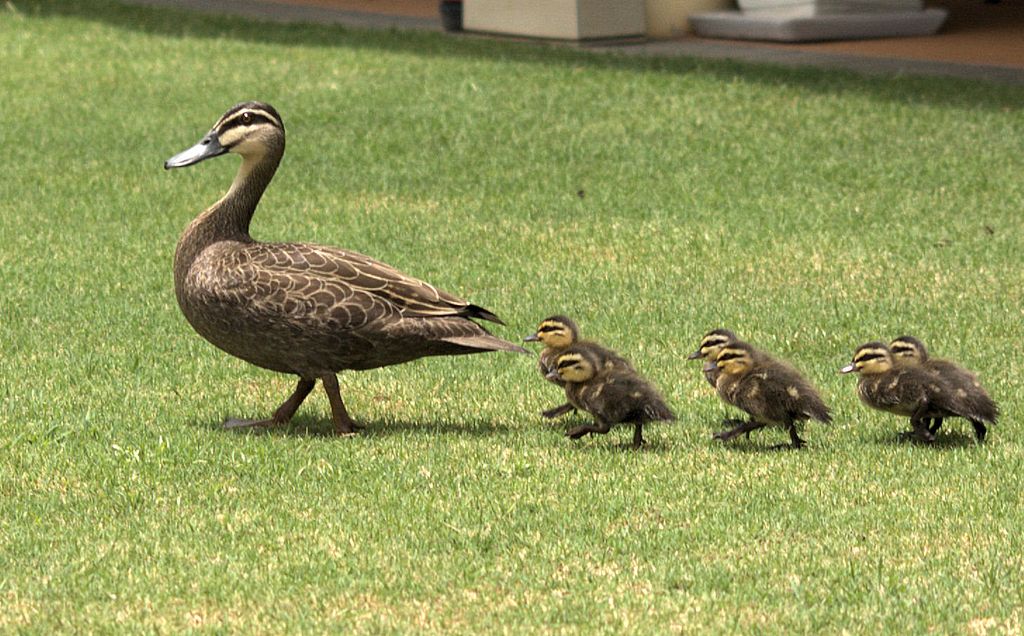 © Wikimedia.org/Paula M Wolter, CC BY-SA
© Wikimedia.org/Paula M Wolter, CC BY-SA
The dunlin (Calidris alpina) is a small wader, formerly sometimes separated with the other 'stints' in the genus Erolia. The English name is a dialect form of 'dunling', first recorded in 1531–1532. It derives from dun, 'dull brown', with the suffix -ling, meaning a person or thing with the given quality. It is a circumpolar breeder in Arctic or subarctic regions. Birds that breed in northern Europe and Asia are long-distance migrants, wintering south to Africa, southeast Asia and the Middle East. Birds that breed in Alaska and the Canadian Arctic migrate short distances to the Pacific and Atlantic coasts of North America, although those nesting in northern Alaska overwinter in Asia. Many dunlins winter along the Iberian south coast. (Source: Wikipedia.org, CC BY-SA)
The dunnock (Prunella modularis) is a small passerine, or perching bird, found throughout temperate Europe and into Asian Russia. Dunnocks have also been successfully introduced into New Zealand. It is by far the most widespread member of the accentor family; most other accentors are limited to mountain habitats. Other common names of the dunnock include: hedge accentor, hedge sparrow or hedge warbler. (Source: Wikipedia.org, CC BY-SA)
Eagle is the common name for many large birds of prey of the family Accipitridae. Eagles belong to several groups of genera, some of which are closely related. Most of the 68 species of eagle are from Eurasia and Africa. Outside this area, just 14 species can be found—2 in North America, 9 in Central and South America, and 3 in Australia. Eagles are not a natural group but denote essentially any kind of bird of prey large enough to hunt sizeable (about 50 cm long or more overall) vertebrates. (Source: Wikipedia.org, CC BY-SA)
The eastern bluebird (Sialia sialis) is a small North American migratory thrush found in open woodlands, farmlands, and orchards. The bright-blue breeding plumage of the male, easily observed on a wire or open perch, makes this species a favorite of birders. The male's call includes sometimes soft warbles of jeew or chir-wi, or the melodious song chiti WEEW wewidoo. It is the state bird of Missouri and New York. (Source: Wikipedia.org, CC BY-SA)
The eastern phoebe (Sayornis phoebe) is a small passerine bird. The genus name Sayornis is constructed from the specific part of Charles Lucien Bonaparte's name for Say's phoebe, Muscicapa saya, and Ancient Greek ornis, 'bird'. Phoebe is an alternative name for the Roman moon-goddess Diana, but it may also have been chosen to imitate the bird's call. (Source: Wikipedia.org, CC BY-SA)
The eclectus parrot (Eclectus roratus) is a parrot native to the Solomon Islands, Sumba, New Guinea and nearby islands, northeastern Australia, and the Maluku Islands (Moluccas). It is unusual in the parrot family for its extreme sexual dimorphism of the colours of the plumage; the male having a mostly bright emerald green plumage and the female a mostly bright red and purple/blue plumage. Joseph Forshaw, in his book Parrots of the World, noted that the first European ornithologists to see eclectus parrots thought they were of two distinct species. Large populations of this parrot remain, and they are sometimes considered pests for eating fruit off trees. Some populations restricted to relatively small islands are comparably rare. Their bright feathers are also used by native tribespeople in New Guinea as decorations. (Source: Wikipedia.org, CC BY-SA)
The Egyptian goose (Alopochen aegyptiaca) is a member of the duck, goose, and swan family Anatidae. It is native to Africa south of the Sahara and the Nile Valley. Egyptian geese were considered sacred by the Ancient Egyptians, and appeared in much of their artwork. Because of their popularity chiefly as an ornamental bird, escapees are common and feral populations have become established in Western Europe, the United States, and New Zealand. (Source: Wikipedia.org, CC BY-SA)
The elegant tern (Thalasseus elegans) is a tern in the family Laridae. It breeds on the Pacific coasts of the southern United States and Mexico and winters south to Peru, Ecuador and Chile. This species breeds in very dense colonies on coasts and islands, including Isla Rasa and Montague Island (Mexico), and exceptionally inland on suitable large freshwater lakes close to the coast. It nests in a ground scrape and lays one or two eggs. Unlike some of the smaller white terns, it is not very aggressive toward potential predators, relying on the sheer density of the nests (often only 20–30 cm apart) and nesting close to other more aggressive species, such as Heermann's gulls, to avoid predation. (Source: Wikipedia.org, CC BY-SA)
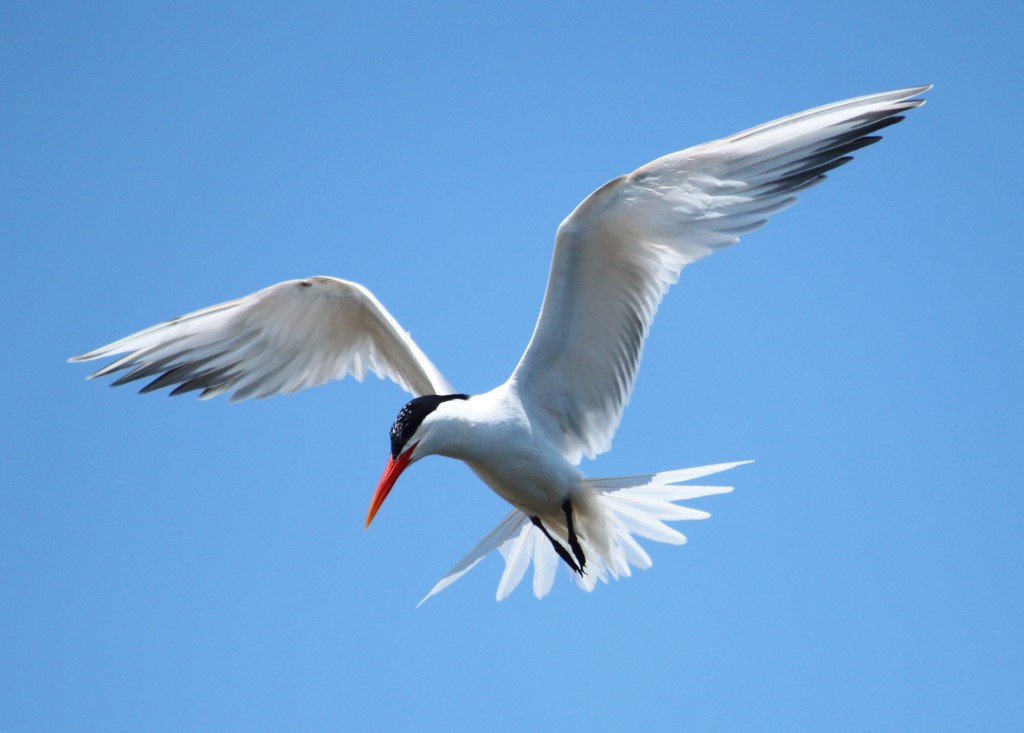 © Wikimedia.org/Regular Daddy, CC BY-SA
© Wikimedia.org/Regular Daddy, CC BY-SA
The emperor penguin (Aptenodytes forsteri) is the tallest and heaviest of all living penguin species and is endemic to Antarctica. The male and female are similar in plumage and size, reaching 100 cm (39 in) in length and weighing from 22 to 45 kg (49 to 99 lb). Feathers of the head and back are black and sharply delineated from the white belly, pale-yellow breast and bright-yellow ear patches. (Source: Wikipedia.org, CC BY-SA)
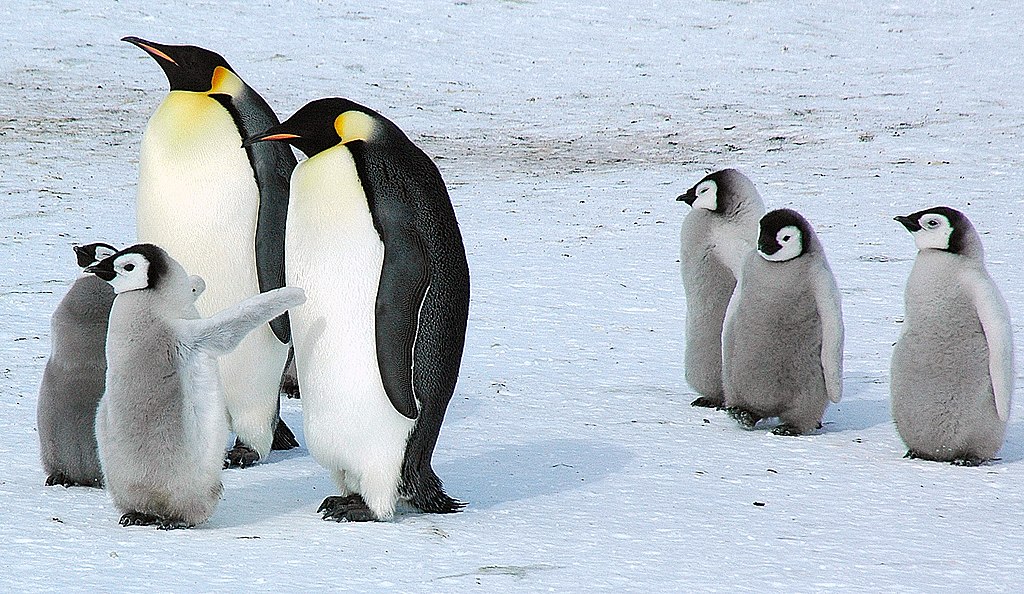 © Wikimedia.org/Denis Luyten, CC0
© Wikimedia.org/Denis Luyten, CC0
The emu (/ˈiːmjuː/) (Dromaius novaehollandiae) is the second-tallest living bird after its ratite relative the ostrich. It is endemic to Australia where it is the largest native bird and the only extant member of the genus Dromaius. The emu's range covers most of mainland Australia, but the Tasmanian, Kangaroo Island and King Island subspecies became extinct after the European settlement of Australia in 1788. Emus are soft-feathered, brown, flightless birds with long necks and legs, and can reach up to 1.9 metres (6.2 ft) in height. Emus can travel great distances, and when necessary can sprint at 48 km/h (30 mph); they forage for a variety of plants and insects, but have been known to go for weeks without eating. They drink infrequently, but take in copious amounts of water when the opportunity arises. (Source: Wikipedia.org, CC BY-SA)
The Eurasian jay (Garrulus glandarius) is a species of passerine bird in the crow family Corvidae. It has pinkish brown plumage with a black stripe on each side of a whitish throat, a bright blue panel on the upper wing and a black tail. The Eurasian jay is a woodland bird that occurs over a vast region from western Europe and north-west Africa to the Indian subcontinent and further to the eastern seaboard of Asia and down into south-east Asia. Across this vast range, several distinct racial forms have evolved which look different from each other, especially when comparing forms at the extremes of its range. The bird is called jay, without any epithets, by English speakers in Great Britain and Ireland. (Source: Wikipedia.org, CC BY-SA)
The Eurasian nuthatch or wood nuthatch (Sitta europaea) is a small passerine bird found throughout the Palearctic and in Europe. Like other nuthatches, it is a short-tailed bird with a long bill, blue-gray upperparts and a black eye-stripe. It is a vocal bird with a repeated loud dwip call. There are more than 20 subspecies in three main groups; birds in the west of the range have orange-buff underparts and a white throat, those in Russia have whitish underparts, and those in the east have a similar appearance to European birds, but lack the white throat. (Source: Wikipedia.org, CC BY-SA)
The European bee-eater (Merops apiaster) is a near passerine bird in the bee-eater family, Meropidae. It breeds in southern and central Europe, northern and southern Africa, and western Asia. Except for the resident southern African population, the species is strongly migratory, wintering in tropical Africa. This species occurs as a spring overshoot north of its usual range, with occasional breeding in northern Europe. (Source: Wikipedia.org, CC BY-SA)
The European robin (Erithacus rubecula), known simply as the robin or robin redbreast in Great Britain & Ireland, is a small insectivorous passerine bird that belongs to the chat subfamily of the Old World flycatcher family. About 12.5–14.0 cm (4.9–5.5 in) in length, the male and female are similar in colouration, with an orange breast and face lined with grey, brown upper-parts and a whitish belly. It is found across Europe, east to Western Siberia and south to North Africa; it is sedentary in most of its range except the far north. (Source: Wikipedia.org, CC BY-SA)
Falcons (/ˈfɒlkən, ˈfɔːl-, ˈfæl-/) are birds of prey in the genus Falco, which includes about 40 species. Falcons are widely distributed on all continents of the world except Antarctica, though closely related raptors did occur there in the Eocene. Adult falcons have thin, tapered wings, which enable them to fly at high speed and change direction rapidly. Fledgling falcons, in their first year of flying, have longer flight feathers, which make their configuration more like that of a general-purpose bird such as a broad wing. This makes flying easier while learning the exceptional skills required to be effective hunters as adults. (Source: Wikipedia.org, CC BY-SA)
The ferruginous hawk, (Buteo regalis), is a large bird of prey and belongs to the broad-winged buteo hawks. An old colloquial name is ferrugineous rough-leg, due to its similarity to the closely related rough-legged hawk (B. lagopus). The generic name buteo is Latin for 'buzzard'. The specific epithet regalis is Latin for 'royal' (from rex, regis, 'king').. The common name 'ferruginous' means 'rust-colored' or 'reddish-brown'. This species is a large, broad-winged hawk of the open, arid grasslands, prairie and shrub steppe country; it is endemic to the interior parts of North America. It is used as a falconry bird in its native ranges. (Source: Wikipedia.org, CC BY-SA)
The true finches are small to medium-sized birds in the family Fringillidae. Finches have stout conical bills adapted for eating seeds and nuts and often have colourful plumage. They occupy a great range of habitats where they are usually resident and do not migrate. They have a worldwide distribution except for Australia and the polar regions. The family Fringillidae contains more than two hundred species divided into fifty genera. It includes species known as siskins, canaries, redpolls, serins, grosbeaks and euphonias. (Source: Wikipedia.org, CC BY-SA)
Flamingos or flamingoes /fləˈmɪŋɡoʊz/ are a type of wading bird in the family Phoenicopteridae, which is the only extant family in the order Phoenicopteriformes. There are four flamingo species distributed throughout the Americas (including the Caribbean), and two species native to Afro-Eurasia. A group of flamingoes is called a 'flamboyance.' (Source: Wikipedia.org, CC BY-SA)
Frigatebirds are a family of seabirds called Fregatidae which are found across all tropical and subtropical oceans. The five extant species are classified in a single genus, Fregata. All have predominantly black plumage, long, deeply forked tails and long hooked bills. Females have white underbellies and males have a distinctive red gular pouch, which they inflate during the breeding season to attract females. Their wings are long and pointed and can span up to 2.3 metres (7.5 ft), the largest wing area to body weight ratio of any bird. (Source: Wikipedia.org, CC BY-SA)
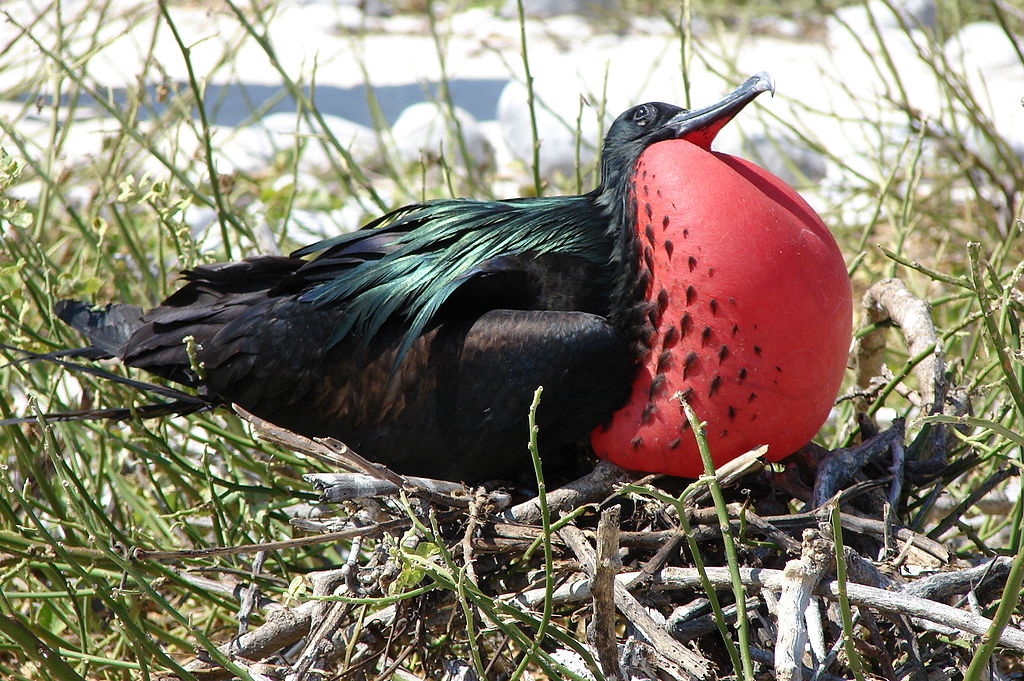 © Wikimedia.org/Jason Corriveau, CC0
© Wikimedia.org/Jason Corriveau, CC0
The Galápagos penguin (Spheniscus mendiculus) is a penguin endemic to the Galápagos Islands, Ecuador. It is the only penguin found north of the equator. Most inhabit Fernandina Island and the west coast of Isabela Island. The cool waters of the Humboldt and Cromwell Currents allow it to survive despite the tropical latitude. The Galápagos penguin is one of the banded penguins, the other species of which live mostly on the coasts of Africa and mainland South America. It is one of the smallest species of penguin in the world. Because of their warm environment, Galápagos penguins have developed techniques to stay cool. The feathers on their back, flippers, and head are black, and they have a white belly and a stripe looping from their eyes down to their neck and chin. Each penguin keeps only one mate, and breeds year-round. Their nests are typically in caves and crevices as protection against predators and the harsh environment. The Galápagos penguin has a lifespan of about 15 to 20 years, but due to predation, life expectancy in the wild could be significantly reduced. (Source: Wikipedia.org, CC BY-SA)
The gentoo penguin (/ˈdʒɛntuː/ JEN-too) (Pygoscelis papua) is a penguin species (or possibly a species complex) in the genus Pygoscelis, most closely related to the Adélie penguin (P. adeliae) and the chinstrap penguin (P. antarcticus). The earliest scientific description was made in 1781 by Johann Reinhold Forster with a type locality in the Falkland Islands. The species calls in a variety of ways, but the most frequently heard is a loud trumpeting, which the bird emits with its head thrown back. (Source: Wikipedia.org, CC BY-SA)
The golden masked owl (Tyto aurantia) is a barn owl endemic to the island of New Britain, Papua New Guinea. It is also known as New Britain barn owl, New Britain masked owl, Bismarck owl and Bismarck masked owl. As with other tropical barn owls, it is difficult to spot in the wild and therefore poorly studied. It is likely to be a lowland forest or coniferous species. Given the paucity of reliable information, it was for some time classified as a data deficient species by the IUCN. When its status could finally be evaluated properly, earlier assessments were found to be correct, and it is once again listed as a Vulnerable species in the 2008 red list. (Source: Wikipedia.org, CC BY-SA)
The Eurasian golden oriole (Oriolus oriolus) also called the common golden oriole, is the only member of the Old World oriole family of passerine birds breeding in Northern Hemisphere temperate regions. It is a summer migrant in Europe and Palearctic and spends the winter season in central and southern Africa. Golden orioles have an extremely large range with large populations that are apparently stable. Therefore, they are evaluated as least concern by BirdLife International. (Source: Wikipedia.org, CC BY-SA)
The European goldfinch or simply the goldfinch (Carduelis carduelis) is a small passerine bird in the finch family that is native to Europe, North Africa and western and central Asia. It has been introduced to other areas, including Australia, New Zealand and Uruguay. The breeding male has a red face with black markings around the eyes, and a black-and-white head. The back and flanks are buff or chestnut brown. The black wings have a broad yellow bar. The tail is black and the rump is white. Males and females are very similar, but females have a slightly smaller red area on the face. (Source: Wikipedia.org, CC BY-SA)
A goose (pl: geese) is a bird of any of several waterfowl species in the family Anatidae. This group comprises the genera Anser (the grey geese and white geese) and Branta (the black geese). Some other birds, mostly related to the shelducks, have 'goose' as part of their names. More distantly related members of the family Anatidae are swans, most of which are larger than true geese, and ducks, which are smaller. (Source: Wikipedia.org, CC BY-SA)
The northern goshawk (/ˈɡɒsˌhɔːk/; Accipiter gentilis) is a species of medium-large raptor in the family Accipitridae, a family which also includes other extant diurnal raptors, such as eagles, buzzards and harriers. As a species in the genus Accipiter, the goshawk is often considered a 'true hawk'. The scientific name is Latin; Accipiter is 'hawk', from accipere, 'to grasp', and gentilis is 'noble' or 'gentle' because in the Middle Ages only the nobility were permitted to fly goshawks for falconry. (Source: Wikipedia.org, CC BY-SA)
The Gouldian finch (Chloebia gouldiae), also known as the Lady Gouldian finch, Gould's finch or the rainbow finch, is a colourful passerine bird that is native to Australia. Both sexes are brightly coloured with black, green, yellow, and red markings. The females tend to be less brightly coloured. One major difference between the sexes is that the male's chest is purple, while the female's is a lighter mauve. (Source: Wikipedia.org, CC BY-SA)
The great blue heron (Ardea herodias) is a large wading bird in the heron family Ardeidae, common near the shores of open water and in wetlands over most of North America and Central America, as well as the Caribbean and the Galápagos Islands. It is a rare vagrant to coastal Spain, the Azores, and areas of far southern Europe. An all-white population found in south Florida and the Florida Keys is known as the great white heron. Debate exists about whether this represents a white color morph of the great blue heron, a subspecies of it, or an entirely separate species. The status of white individuals known to occur elsewhere in the Caribbean, and their existence is rarely found elsewhere besides in eastern North America. (Source: Wikipedia.org, CC BY-SA)
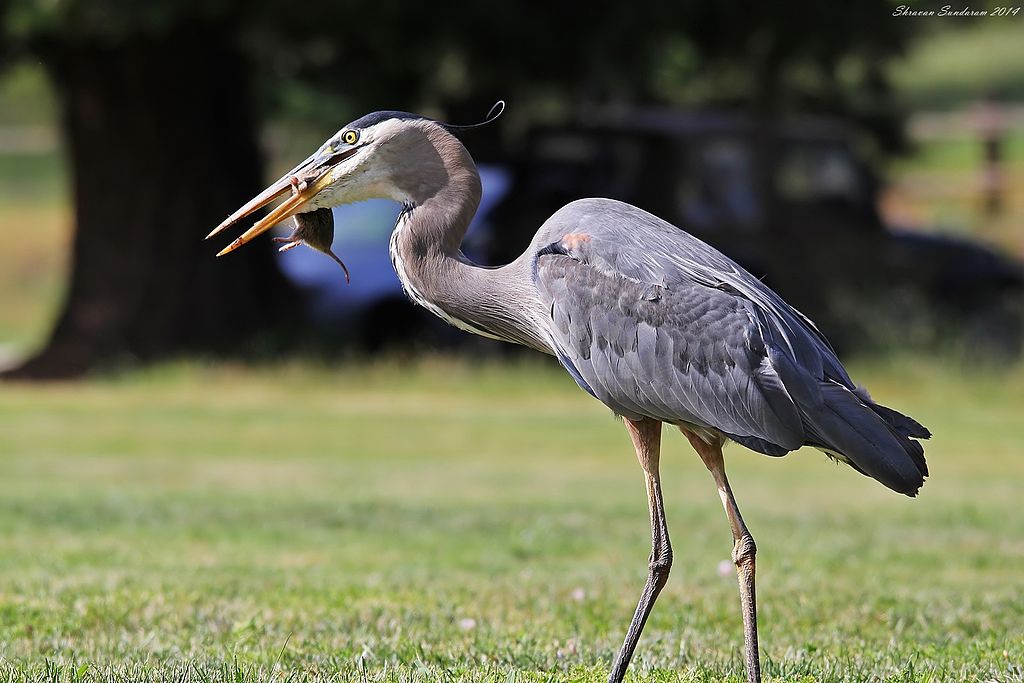 © Wikimedia.org/Shravans14, CC BY-SA
© Wikimedia.org/Shravans14, CC BY-SA
The great crested flycatcher (Myiarchus crinitus) is a large insect-eating bird of the tyrant flycatcher family. It is the most widespread member of the genus Myiarchus in North America, and is found over most of the eastern and mid-western portions of the continent. It dwells mostly in the treetops and rarely is found on the ground. Adult great crested flycatchers usually measure between 17–21 cm (6.7–8.3 in) in length with a wingspan of around 34 cm (13 in). This bird usually weighs between 27–40 g (0.95–1.41 oz). (Source: Wikipedia.org, CC BY-SA)
The great egret (Ardea alba), also known as the common egret, large egret, or (in the Old World) great white egret or great white heron is a large, widely distributed egret. The four subspecies are found in Asia, Africa, the Americas, and southern Europe. Recently it is also spreading to more northern areas of Europe. Distributed across most of the tropical and warmer temperate regions of the world, it builds tree nests in colonies close to water. (Source: Wikipedia.org, CC BY-SA)

Time for recess! Post a comment, ask a question or write a review. Feel free to let us know what you think!
Below are wonderful knowledge resources for foreigners willing to Drive in Malaysia: Driving in Malaysia: What Foreign National Drivers Should Know? https://driveinmalaysia.com/blog/2022/driving-in-malaysia-what-foreign-national-drivers-should-know/ What Foreign Students in Malaysia Should Know about Driving Licence and its Conversion? https://driveinmalaysia.com/blog/2024/guide-on-malaysian-driving-license-and-its-conversion-for-foreign-students/
when you have a wrong answer the next will be counted wrong too no matter if it's right. This could leed to confusion.
Amazing website with all basic Rules .Much more appreciated and my sincere gratitude .
81/85 as an Italian who never drove in US, wonder if that's enough to pass the licence test there?
look at the sign on the road to avoid accidents and horrible driving conditions
I received a 300$ ticket because I passed a police control of other cars/drivers on the right lane of a highway (the control was on the hard shoulder of the highway). Is it really true, that you have to change the lane in such cases? Thanks!
I am an American living in Italy. The Italian Drivers License theory test is the hardest test I have ever studied for and I am in my 70s have multiple degrees, multiple professional certifications. Have to take the Italian Drivers Theory test in Italian. No english. So many rules. More signs in small medieval Italian town I live in then in major US cities I have lived in. No Italian license no driving. No buying or renting a car. Test here was good, clean. Lots of tricky questions on many practice and real official tests. Thanks
More community